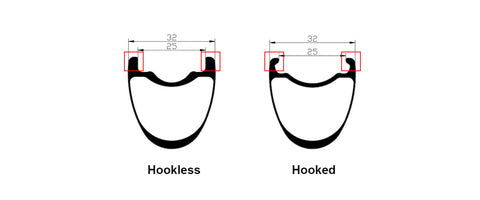The ultimate guide to hooked and hookless bike rims - differences, compatibility and possible uses
Choosing the right bicycle rim is crucial for a safe and comfortable ride. When choosing a rim, factors such as tire type, riding style and compatibility with the bike and tire setup should be considered. Two popular rim designs are the hook rims and the hookless rims, each with its own advantages and disadvantages. While hook-shaped rims provide additional mechanical closure and security, hookless rims are easier to install and offer better impact resistance. Additionally, the hybrid hook design combines the benefits of both designs by providing a smoother transition from tire to rim and a higher maximum pressure limit. Ultimately, the choice between hooked and hookless rims depends on your riding needs, the type of tire, and the pressure you prefer.
Difference between hook rim and hookless rim
A hook rim and a hookless rim are two different designs commonly found in bicycle rims, especially in the context of tubeless rims. The main difference lies in the way the tire bead is held on the rim.

1. Hooked Rim:
A hooked rim has a pronounced, inward-facing hook or flange on the inside edge of the rim sidewall. This hook helps hold the tire bead in place and prevents it from coming loose from the rim, especially under high pressure. Traditionally, most rims were designed with hooks to accommodate clinchers (tires with tubes) because the hook provided a reliable mechanical lock.
2. Hookless rim:
A hookless rim, as the name suggests, lacks the distinctive hook or flange on the inner edge of the rim. Instead, it has a straight sidewall profile with no inward-facing hook. The tire bead relies on a precise fit and air pressure to sit securely in the rim. Hookless rims are usually designed for tubeless systems, where the tire forms an airtight seal with the rim well without a tube.
Key differences between hooked and hookless rims include:
a. Mounting the tire:Rims with hooks usually require more effort to mount and remove the tire due to the hook. With hookless rims, however, tire installation is often more effortless.
b. Bead Lock:Rims with hooks provide additional mechanical locking by pressing the tire bead against the hook, providing additional security, especially at high pressures. With hookless rims, the bead is held in place by a tighter fit between the tire bead and the rim base and by air pressure.
c. Impact Resistance: Hookless rims often have a more robust design with thicker sidewalls to compensate for the absence of the hook. This design increases the impact resistance and durability of the rim.
d. Compatibility: Hooked rims are generally compatible with both clincher tires (with tube) and tubeless tires (with sealant). Hookless rims are primarily suitable for tubeless tires, as the lack of a hook can make it difficult to attach tires with tubes.
3. Hybrid Hook rim
The Hybrid Hook Design combines the advantages of hookless and hook-shaped wheels. With this design, the transition from tire to rim is almost as smooth as hookless wheels, giving a slight aerodynamic advantage over traditional hooked wheels. Additionally, the maximum air pressure on Hybrid Hook wheels is approximately five psi higher than our hookless wheels, meaning the risk of a tire blowout is significantly lower.
Who is the Hooked Rim suitable for?
Many road cyclists who value performance are hesitant to switch to hookless rims due to tire compatibility and pressure limitations. Hookless rims are not suitable for those who want to ride above 72psi or have tires that are less than 5mm wider than the rim. If you value aerodynamic benefits and ride primarily on smooth roads, hookless rims could be a good option for you. However, if you plan on riding with high air pressure, a hookless rim is a safer choice for now.
Who is Hookless Rim suitable for?
Many drivers have moved to using larger volume, lower pressure tires. Hookless rims can simplify installation, provide greater safety, provide more impact protection at lower pressures, and be a lighter and slightly cheaper option.
Although mountain bikes have long used hookless rims, it is important to note that the requirements of mountain biking are very different from those of road riding. Mountain bike rims are lighter and wider, and their edges are designed for impact resistance rather than aerodynamics. Mountain bike tires are also stiffer and require much lower air pressure. The lower pressure offers several advantages, including a reduced risk of blow-off. When purchasing mountain bike wheels, hookless tires are your best choice.
Can I use hookless tires on hook rims?
All tubeless-capable tires are compatible with hook rims.
Maximum tire pressure
Many rim and tire manufacturers have discovered that hooks can significantly increase the pressure at which a tire remains securely on a rim. Hooked road rims have a maximum tire pressure of 115 psi (60 psi for gravel rims), while hookless road rims have a limit of 75 psi (55 psi for gravel rims).





